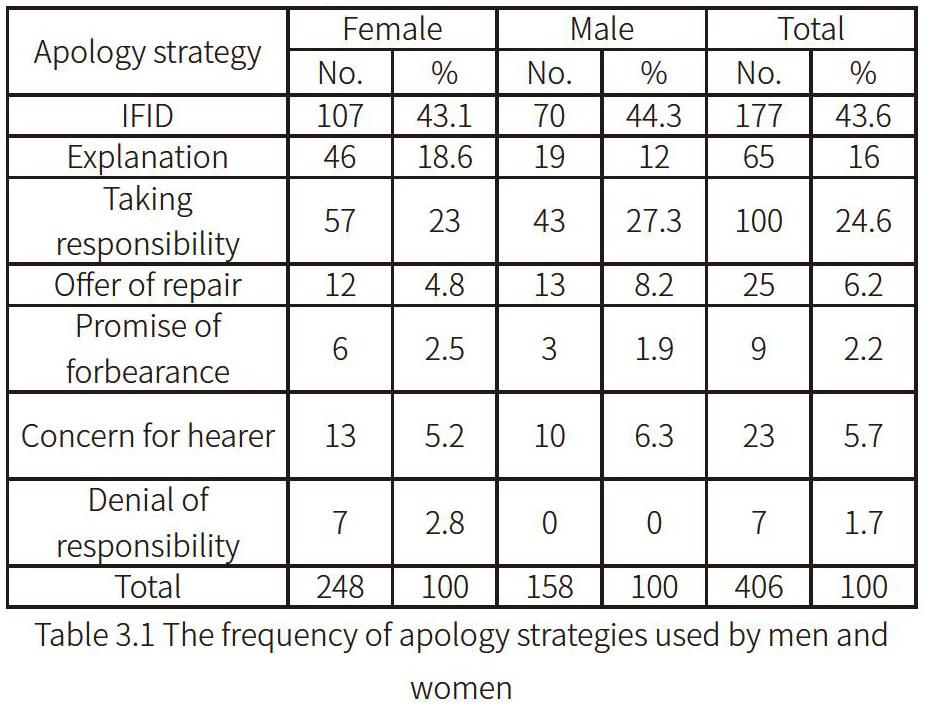Gender Differences in Apologies in Chinese by College Students
2020-08-26任俊超

1. Introduction
Nowadays, there are a large number of studies on gender difference in language use, however, most of them are limited to western languages, with a few on localized apology performance in Chinese (Guo, 2010, p.177). Therefore, this study attempts to present the gender differences in the performance of apology speech act, especially differences in use of apology strategies between female and male college students.
2. Methodology
2.1 Data collection
This study is conducted on the basis of the corpus of 219 apology exchanges in spoken Chinese mandarin which are extracted from six Chinese TV series and two novels. The TV series and novels are chosen from those produced in recent years, all of which describe the life of college students. Since age and education are important sociolinguistic variables which have great effect on the language use, the data collected for this study are all produced by college students as a special social group in order to ensure the homogeneity.
The genre of the TV series and novels is strictly limited to those presenting normal life of college students, without those about horror, violence or gunfire. The plots and the interaction between characters are similar to what happens in real daily life. The conversation and language use is close to those in real life as well so that valid data can be ensured. TV series chosen in this study are listed as follows: At the End of College Life,Summer in Being, Red Apple Home, Dream of being a supper star, Smell of Sunshine, Peacock Blue; and two novels are To Our Past Youth, and A Gentlemans Word. When watching TV series and reading novels on line, the author noted down the dialogues involving expressions of apology in Chinese in the Excel form prepared beforehand. However, in some cases, a direct strategy of apology (with words like “sorry”, “apologize”) does not appear, but other indirect strategies are used. This kind of conversation is also taken down in the Excel form since the author can clearly feel the regret either through his/her countenance or gesture. The Excel form contains 6 items: the name of the play, the time when the apology occurs, and the apologizer ,the apologizee, the context (why the apology is performed), the exact words that are uttered, and the response from the apologizee. Actually, this form indeed provides enough information for the author to examine every apology .
Most of the research into apologies is based on the data elicited through role-play or discourse completion test (DCT). It has been argued that “elicited data are valuable since they reveal the forms that natives and non-natives know, and show the range of strategies that the respondents think they would use in specific situations” (Mohammad & Fariba, 2010). These TV series and novels, though not equivalent to real life, actually are created according to reality and the language between speakers are naturally produced since set in the context. Toolan (1985) asserts that “the crucial structural and functional principles and patterns are at work in literary dialogues as they are in natural conversation”, and therefore the conversations and language use in TV series and novels are very close to those appearing in real life. To sum up, the data collected from TV series and novels in this study might include a comparatively more natural language than DCT.
2.2 The coding scheme
Different classification systems have been proposed for apology strategies, as presented in the previous chapter. In this study, the data are analyzed according to the modified framework proposed by Olshtain and Cohen (1983).
3. Results and discussion
Within the 219 apology exchanges collected in this study, 406 pieces of strategy use are found. Two or more different sub-strategies of are used in some situations, and each of these sub-strategies is counted as one occurrence. Table 3.1 shows the frequency of different apology strategies used by male and female college students in the data.
The distribution of female and male apology strategies shows they have a very similar pattern as a whole. There is the same frequency order of apology strategies preferred by both genders in the overall situations. Table 3.1 shows that both male and female students are apt to use three strategies: IFID, taking responsibility, and explanation. The strategy of IFID is the most frequently used one by both genders, which takes up more than 40% of the total apology strategies. 172 apology exchanges among 219, that is, 78.5% of the situations, contain a form of IFID.
The second frequently used strategy is “Taking responsibility”, which is used in 93 apology exchanges (42.5% of the total number of situations). It seems that this strategy is more popular with male students (27.3%) than female students (23%). This may be related to their different way of thinking and behavior. Men are taught to be brave and honest, to shoulder the responsibility and duty, and thus they are more straightforward and react promptly to solve the problem or to repair the offence committed. The following widely-used strategy is explanation (occurring in 64 pieces of apology exchanges), in which gender difference appears most obviously: female students (with 18.6% of the whole distribution) tend to resort to explanation more than male students (with a percentage of 12%). Gender difference also appears in the frequency of Offer of repair (the fourth mostly-used strategy) which has a higher frequency in the distribution of males apology strategies than in females. Besides, promise for forbearance, concern for hearer and denial of responsibility are the strategies least used, with no significant difference between women and men.
The result shows that, the distinction between “dui bu qi” and “qing yuan liang” is merely concerned with light intrusion on interpersonal relationship; while “excuse me” is used in situations with damage of social norms therefore bear serious regret and plead formal forgiveness from the victim, hence, Chinese people are always cautious and prudent to employ such expression when an offence is committed. The data found in my study are in line with this finding.
There is slight gender difference in the frequency of offering strategy that male students (27.3%) use it more often than female students (23%). This may be explained by the assertion that men are goal-oriented and more straightforward. Once the offence occurs, his prompt reaction is to come up with a fast solution. They tend to believe that the simple use of other strategies such as IFID, taking responsibility and explanation is not enough, and the strategy of offering of repair can add weight to the remedial work.
4. Conclusion
Based on the tables, there are no significant gender differences in the speech act of apology. As to apologetic strategies, the IFIDs and taking responsibility are the most frequently used ones for both male and female students, while promising for forbearance, concern for the hearer and denial of responsibility are least used among seven strategies. Gender differences are showed in frequency of strategies and sub-strategies used. That is, female students have a more employment of the explanation strategies than male students, while male students use taking responsibility and offering of repair more than female ones. When examining the sub-strategies of IFIDs, it is found that male students seem to employ comparatively more formal sub-categories (an offer of apology) than female students.
References:
[1]Holmes, J. Sex differences and apologies: One aspect of communicative competence[J]. Applied Linguistics, 1989,10:194-213.
[2]Mohanmmad, S. & Fariba, C. Apology Strategies in Persian[J]. Journal of Pragmatics, 2010,42:1689-1699.
【作者簡介】任俊超,三亚学院外国语学院。
